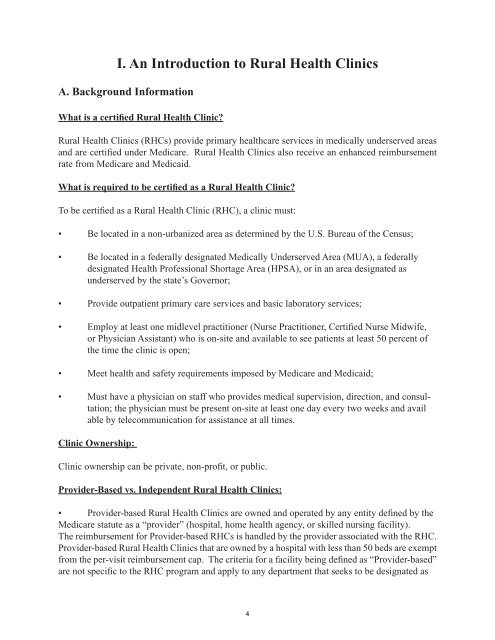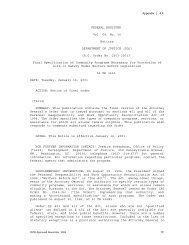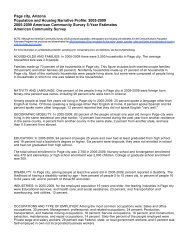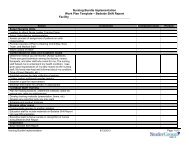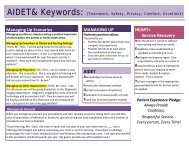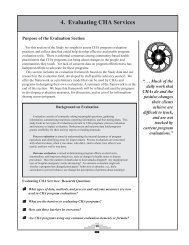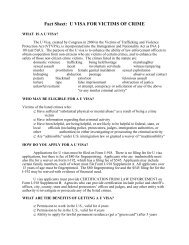Arizona Rural Health Clinic Designation Manual - Arizona Center for ...
Arizona Rural Health Clinic Designation Manual - Arizona Center for ...
Arizona Rural Health Clinic Designation Manual - Arizona Center for ...
You also want an ePaper? Increase the reach of your titles
YUMPU automatically turns print PDFs into web optimized ePapers that Google loves.
I. An Introduction to <strong>Rural</strong> <strong>Health</strong> <strong>Clinic</strong>s<br />
A. Background In<strong>for</strong>mation<br />
What is a certified <strong>Rural</strong> <strong>Health</strong> <strong>Clinic</strong><br />
<strong>Rural</strong> <strong>Health</strong> <strong>Clinic</strong>s (RHCs) provide primary healthcare services in medically underserved areas<br />
and are certified under Medicare. <strong>Rural</strong> <strong>Health</strong> <strong>Clinic</strong>s also receive an enhanced reimbursement<br />
rate from Medicare and Medicaid.<br />
What is required to be certified as a <strong>Rural</strong> <strong>Health</strong> <strong>Clinic</strong><br />
To be certified as a <strong>Rural</strong> <strong>Health</strong> <strong>Clinic</strong> (RHC), a clinic must:<br />
• Be located in a non-urbanized area as determined by the U.S. Bureau of the Census;<br />
• Be located in a federally designated Medically Underserved Area (MUA), a federally<br />
designated <strong>Health</strong> Professional Shortage Area (HPSA), or in an area designated as<br />
underserved by the state’s Governor;<br />
• Provide outpatient primary care services and basic laboratory services;<br />
• Employ at least one midlevel practitioner (Nurse Practitioner, Certified Nurse Midwife,<br />
or Physician Assistant) who is on-site and available to see patients at least 50 percent of<br />
the time the clinic is open;<br />
• Meet health and safety requirements imposed by Medicare and Medicaid;<br />
• Must have a physician on staff who provides medical supervision, direction, and consultation;<br />
the physician must be present on-site at least one day every two weeks and avail<br />
able by telecommunication <strong>for</strong> assistance at all times.<br />
<strong>Clinic</strong> Ownership:<br />
<strong>Clinic</strong> ownership can be private, non-profit, or public.<br />
Provider-Based vs. Independent <strong>Rural</strong> <strong>Health</strong> <strong>Clinic</strong>s:<br />
• Provider-based <strong>Rural</strong> <strong>Health</strong> <strong>Clinic</strong>s are owned and operated by any entity defined by the<br />
Medicare statute as a “provider” (hospital, home health agency, or skilled nursing facility).<br />
The reimbursement <strong>for</strong> Provider-based RHCs is handled by the provider associated with the RHC.<br />
Provider-based <strong>Rural</strong> <strong>Health</strong> <strong>Clinic</strong>s that are owned by a hospital with less than 50 beds are exempt<br />
from the per-visit reimbursement cap. The criteria <strong>for</strong> a facility being defined as “Provider-based”<br />
are not specific to the RHC program and apply to any department that seeks to be designated as<br />
4


